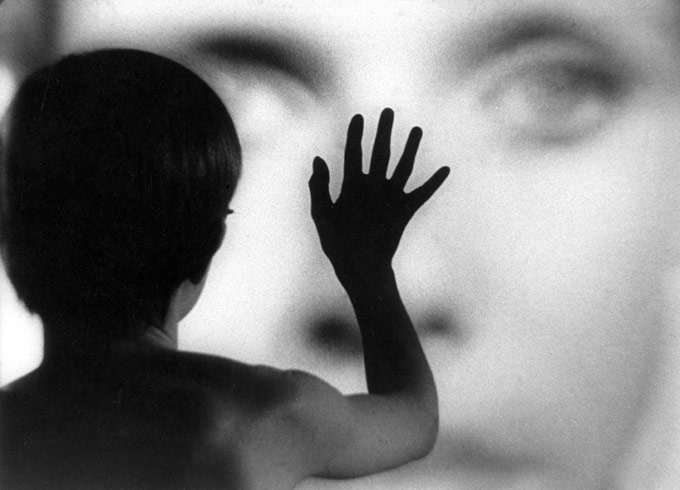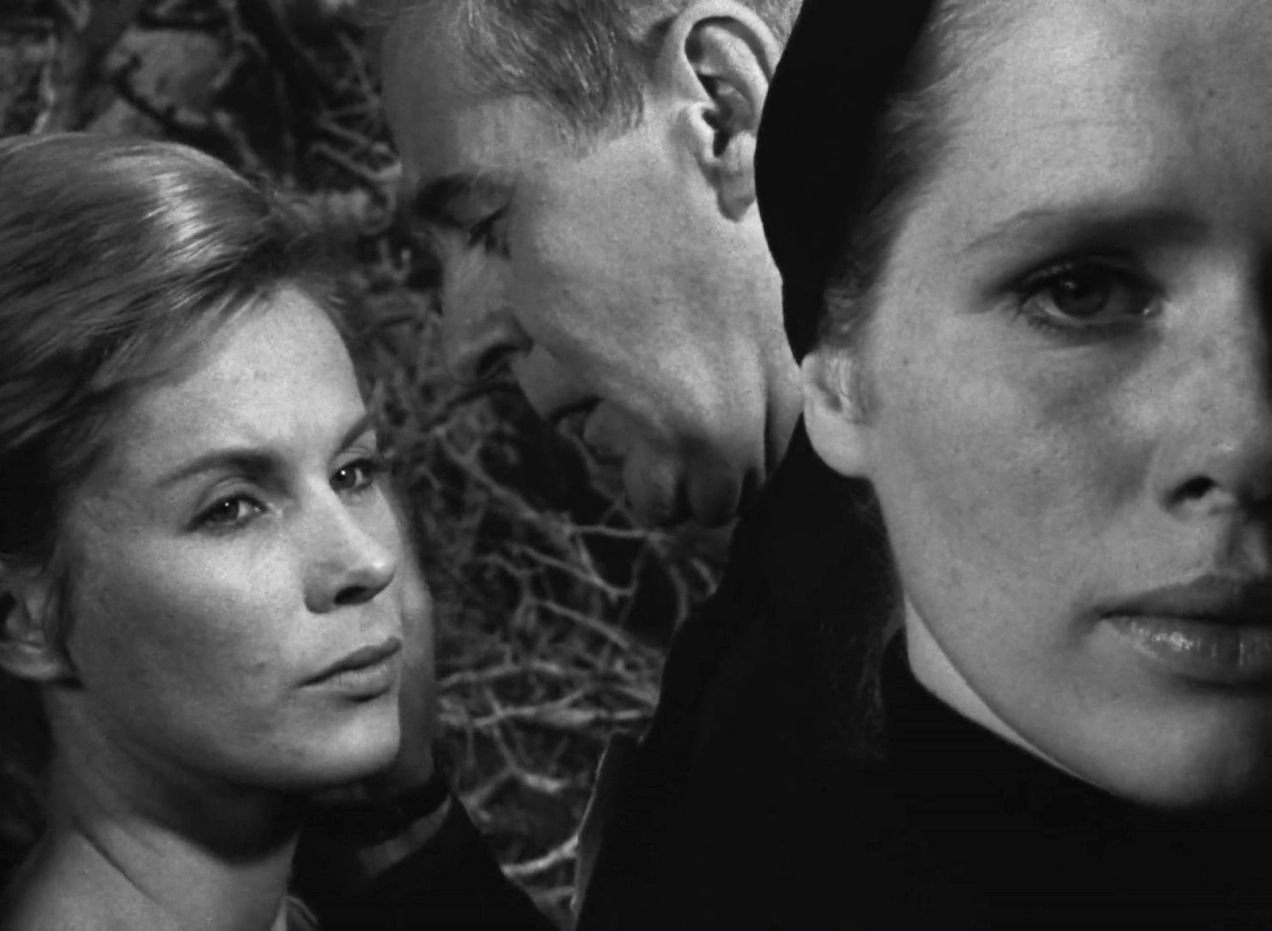Persona (1966) is a prime example of playwright Henrik Ibsen’s influence on Ingmar Bergman. It is a film that in its metafilmic montage prologue proclaims the cleaning out of the old Bergman (iconography, themes, motifs) and the dawn of a director reborn. The boy in the prologue, played by Bergman-as-a-kid-lookalike Jörgen Lindström from The Silence (Tystnaden, 1963), is an investigator not only into the minds of the film’s two female protagonists but also into this new Ibsenian landscape of women struggling to break free of the legacy of the German Idealism. This was the bourgeois ideology that imprinted on women from the 19th and most of the 20th century that it was their destiny, first and foremost, to be self-sacrificing mothers and keepers of the family.
The boy is Elisabet’s rejected son and Alma’s aborted foetus, and his (and our) vantage point is from within their shared womb – that is, what patriarchy has defined as the core of the female mind. In his 1960s stage production of Hedda Gabler, Ibsen’s study of the downfall of a woman poisoned by idealism, Bergman had shown the title character as pregnant and disgusted by the product of her unwanted sexual desires. She even tries to abort the foetus by her bare hands (Koskinen 2001, p. 54; Moi 2008, p. 317). In Persona, we get to see this inner struggle as a Bergmanian dream play set in the mind/womb of a woman, who is split into two entities locked in a power struggle.

Bergman regards art in the screenplay’s ‘foreword’, “The Snakeskin” (“Ormskinnet”), as “free, shameless, irresponsible”, something the idealist nurse Alma (Bibi Andersson) will learn from the modernist actress Elisabet (Liv Ullmann).* Alma considers art as therapeutic, edifying and comforting. Christopher Orr (2000, p. 89) regards her views to be an assessment of art as melodrama, a genre intended “to facilitate our adjustment to social reality”.
At the beginning of the film, Alma is so well adjusted that she is almost an idealist prototype of the self-sacrificing woman, passionately clinging to utopian ideas about family life with marriage, a husband and children. In a monologue, she perceives her life as a wife and mother as her destiny – natural and predetermined – though her declamation betrays her idealist theatricalisation of herself.
Her patient, Elisabet, has done the very opposite: rejected her idealist imprint, thereby also rejecting that ideology’s definition of her as a wife, as a mother and, indeed, as a woman. She represents the continuation of Ibsen’s heroines and their troubled relationships with idealism in A Doll’s House, The Wild Duck. and Hedda Gabler. Bergman marries Ibsen with Carl Jung’s persona symbolism – “a compromise between the individual and society as to what a man should appear to be” – to stage women’s “inner sabotage of themselves”. **

The main part of the action in Persona consists of Alma trying to reprogram Elisabet to the social order in accordance with the dominant ideology. Elisabet refuses by maintaining an amoral and asocial stance, though she is clearly moved by images from the Vietnam War and the Nazi Holocaust. Aided by Bergman’s modernist, disjunctive techniques of narration, the film becomes a symbolic defeat of idealism by modernism.
For all her efforts to get Elisabet back in the idealist fold of womanhood, it is Alma’s own ideology that crumbles. Her initial monologue of trust in the role designated for her by the idealist hegemony turns out to be a persona which is at odds with her innermost feelings. Her sexual repression is highlighted by the scene in which she talks about the pleasures of a spontaneous orgy at a secluded beach, contrasting with her feelings of being “cold and rotten” when having marital sex as Elisabet’s stand-in.
Likewise, her longing for children is called into question by the abortion that we learn of and by the twice-spoken monologue in which Alma presumes to speak Elisabet’s mind only to express her own true sentiments. There she reveals that her longing for motherhood is all based on an ideological construction, not individual desire. Her true but repressed notion of being a mother is one of horror, disgust, guilt and self-loathing. At that point in the film, Alma and Elisabet are fused together in the film’s emblematic shots of their complementary face halves.

The journey from their shared womb in the opening to their shared minds is complete, and the hypocrisy of idealism is exposed by Alma’s confession while pretending to speak for Elisabet. Consequently, the language of hegemony that she has used throughout the film is revealed as corrupted, and it breaks clown into meaningless phrases despite Alma’s effort to restore social order by putting on her nurse uniform. As a last resort, she chooses to repress Elisabet and everything that has happened between them.
We are suddenly back at the hospital, where Alma urges Elisabet to repeat the word “nothing” (“ingenting”). When Elisabet does so, Alma is pleased. The only other sound in the scene is from church bells ringing, reminding us of the repressive structures foregrounded in several of Bergman’s previous films: patriarchal Christianity. The scene ends in a Bergmanian white fade-out that corresponds with the white fade-in of the door at the end of the opening montage and the beginning of the main narrative. Perhaps all that we have seen has been but a dream, Alma’s and ours.
At the end of the film, Alma and Elisabet go their separate ways, back to their old lives. The last glimpse of Alma is of her getting on a bus dressed in her old, drab and conservative clothes. Elisabet is seen making a film by Ingmar Bergman – we glimpse his director’s chair in the shot where his camera crew are taking a crane shot –suggesting that she has been the director’s agent in the narrative. In this context, the brief encounter between the women also becomes a metaphor for the reception of modernist art, more specifically Bergman’s previous film: The Silence.

Appreciated ‘for all the wrong reasons’, The Silence’s reception is parodied in the opening montage of Persona by the flash images of an erect penis and of lips suggesting a vagina. But it is also mocked by Alma’s efforts to apply her idealist model of melodrama in her responses to Elisabet. This time, Bergman’s modernist film resists by returning the look. Elisabet the actor and Alma the audience switch places so that Elisabet is the one who watches in silence while Alma becomes the one who performs. Revealing her innermost secrets, Alma’s sense of identity and ultimately her worldview are deconstructed as hypocrisy and self-deception – “a tangle of lies”, as Karin says in Cries and Whispers (1973).
Bergman’s art cinema narrative does not end with a conventional melodramatic resolution that readjusts the protagonists and the audience to the social order. It has an open ending appropriate to Bergman’s favourite saying that his job was not to provide the answers but the questions.’ In other words, he was not political in the sense that he was making didactic films providing ready-made political answers, but his modernist strategies certainly have political implications. To summarise, we can apply Toril Moi’s list of Ibsen’s key modernist features to the film.
Persona is metafilmic in the same sense that Ibsen’s plays arc metatheatrical: it constantly reminds us that we are watching a film. Film form is thus embraced and acknowledged. The main story is about the clash between idealism and modernism, resulting in an ironic defeat of idealism as hypocritical and (self-)destructive. Although Elisabet is the theatre actress, it is Alma who theatricalises herself by inscribing herself in various scenarios of female sacrifice. This is foreboded in the overwrought radio play we hear at the hospital featuring a woman pleading for forgiveness.

For a start, the whole scenario – which could be interpreted as Alma’s dream – with her dropping everything to be some sort of assistant or maid to an actress for months, is anything but realistic. At the summer cottage, she talks with enthusiasm about her self-sacrificing work, only to forget it in an instant when making a thoughtless comment on the heavy rain. Elisabet’s hard look at her is telling of Alma’s poor theatrical performance. Already in Alma’s aforementioned monologue we have become aware of her self-theatricalisation, and during the film we will see her utopian ideas of love collide with her stories about sexual affairs and infidelities.
In all this theatricalisation, her love for future husband Karl-Henrik seems to be of lesser, if any, importance. When she describes their relationship and forthcoming marriage it sounds more like an idealist construct – a kind of marriage out of convenience – than love. Her stand-in performance as Elisabet when having sex with the actress’s husband becomes an omen of what lies ahead for her – a cold, perhaps even hateful relationship of the kind Bergman has depicted in previous films such as Wild Strawberries (Smultronstället, 1957) and would continue to explore in Scenes from a Marriage (Scener ur ett äktenskap, 1973), Face to Face (Ansikte mot ansikte, 1975) and From the Life of the Marionettes (Aus dem Leben der Marionetten, 1980).
Finally, the situation of women as the key to modernity is central. Bergman’s notion of “the women’s inner sabotage of themselves” locates patriarchal ideology not primarily as the outer repression of women by men, but as an imprint on the women’s own minds – their inner police. If we take the main narrative as Alma’s projection, dream or ‘mindscreen’, then Elisabet represents everything she has to repress in order to restore the presumed normality of her idealist frame of mind. Like Ibsen’s Hedda Gabler, Alma chooses death, though not by suicide but by becoming a Bergmanian living dead. We will meet her sisters in the films and TV productions discussed below.
* “The Snakeskin” was originally Bergman’s response to being awarded the Erasmus Prize in 1965; quote in Bergman 1966, p. 10. The text was, however, not coincidentally included as a kind of foreword to the Persona screenplay.
** See Jung 1916, reprinted in Campbell 1976, p. 106.
*** See, for instance, the talk show Kvällsöppet, 9 April 1971, following a rerun of The Lie (Reservatet, 1970).

Literature
Carl Jung “The Relations Between the Ego and the Unconscious” (1916). Joseph Campbell (ed.) The Portable Jung. New York: Viking Press.
Maaret Koskinen ‘Allting föreställer, ingenting är’: Filmen och teatern – en tvärestetisk studie. Nora: Nya Doxa, 2001.
Toril Moi Henrik Ibsen and the Birth of Modernism: Art, Theater, Philosophy. Oxford: Oxford University Press, 2008.
Christopher Orr “Scenes from the Class Struggle in Sweden”. Lloyd Michaels (ed.) Ingmar Bergman’s ‘Persona’. Cambridge: Cambridge University Press, 2000.
© Michael Tapper 2017. Excerpt from Michael Tapper Ingmar Bergman’s ‘Face to Face’. New York: Wallflower Press/ Columbia University Press, 2017, p. 54–58. Slightly edited and expanded for clarity.